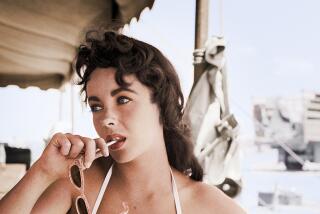A radiant life
âTell Mama. Tell Mama all.â
If you are a fan of Elizabeth Taylor, and how could you not be, you donât have to be told the source of that dialogue. Itâs the heart of Taylorâs country club love scene with Montgomery Clift in âA Place in the Sun,â and the actressâ face in huge close-up is so exquisitely, so heartbreakingly beautiful you never doubt that Cliftâs intoxicated character would do anything to keep her in his life. Up to and including murder.
Both on the screen and off, Elizabeth Taylor and her irresistible violet eyes had that effect on men. She was only 17 when she filmed that scene for director George Stevens in 1949 (the film was released two years later), and her career as a talented adult actress and world-class femme fatale was just beginning. Before she was finished, Taylor had collected five Oscar nominations, two victories, seven husbands and innumerable broken hearts.
In this and in many things, the actress was in a class by herself. Her astonishingly dramatic personal life, characterized by full-throttle romantic love and later recriminations, serious illnesses and tragic deaths, matched the drama of her on-screen roles stride for stride and maybe even bested it. While many actresses specialize in public private lives, itâs hard to think of another one quite as astounding in its fearless pursuit of happiness as Taylorâs.
She began as a child actress, on screen at age 10, and the best of her early films, which often matched her with animals, still captivate today. Both âLassie Come Homeâ in 1943 and âNational Velvetâ a year later showcase a youthful performer with uncommon determination and poise.
As a young adult, Taylor was luminous with the promise of youth not only in âA Place in the Sun,â based on Theodore Dreiserâs âAn American Tragedy,â but also costarring with Spencer Tracy in the still-charming 1950 âFather of the Bride.â
âGiantâ marked another step forward, as Taylor was the cynosure of all eyes as the romantic interest fought over by Rock Hudson and James Dean. The same thing happened in the screen version of Tennessee Williamsâ sultry âCat on a Hot Tin Roof,â with the actress playing Maggie the Cat and holding the screen with Paul Newman and Burl Ives with the help of a seductive white slip.
Though MGM, not Yale Drama, was her acting school, Taylor was a gifted performer, more than she gave herself credit for. She was nominated for the lead actress Oscar four years in a row before winning it on the fourth try for another slip role, a high-class call girl in 1960âs âButterfield 8.â
That victory, Oscar historians claim, came partially as a gesture of sympathy after a severe case of pneumonia nearly killed her. It was not the first or the last time her private life merged with and accentuated her movie star appeal.
Taylorâs first brush with tragedy came in 1958, when her third husband, producer Mike Todd, died in a plane crash after little more than a year of marriage. Just as shocking to America was the way she immediately took up with Eddie Fisher, married to Americaâs sweetheart Debbie Reynolds and the best man at her wedding to Todd.
All this was just a warm-up for Taylorâs volcanic relationship with the great Welsh actor Richard Burton. They met on the set of âCleopatra,â a flop of legendary proportions, married, divorced, remarried, re-divorced and made a number of films together, from the forgettable to the one that won Taylor her second Oscar, âWhoâs Afraid of Virginia Woolf?â
I never met Elizabeth Taylor, but when I think of her career I think of a moment when I saw her across a crowded room, the Washington Post newsroom in the mid-1970s, where I worked and where the actress was paying a kind of Hollywood state visit.
Other stars had come to the Post newsroom in the post-Watergate era, and despite their celebrity they had often tried unsuccessfully to blend in to the point where they were irritated if people gawked. Not Elizabeth Taylor.
Dressed to be noticed, her fabulous eyes accentuated by makeup, huge diamonds on her hands, she knew she was a star and relished, even cherished her position. She will be missed.
--
--
(BEGIN TEXT OF INFOBOX)
âWhat Iâll always remember about Elizabeth was her laugh. She would walk into a room looking like a princess, and suddenly there would be this cackle that filled the room that would crack us all up. Iâm so glad to have known her.â
-- Barry Manilow
âWe have just lost a Hollywood giant; more importantly, we have lost an incredible human being.â
-- Elton John
âI shall remember her as a woman whose heart and soul were as beautiful as her classic face and majestic eyes.â
-- former husband and Sen. John W. Warner
âI donât know what was more impressive, her magnitude as a star or her magnitude as a friend. Her talent for friendship was unmatched. I will miss her for the rest of my life and beyond.â
-- Shirley MacLaine
âIt wasnât just her beauty or her stardom. It was her humanitarianism. She put a face on HIV/AIDS. She was funny. She was generous. She made her life count.â
-- Barbra Streisand
âElizabeth Taylor was a dear friend. I knew her from our days together at MGM when she was just a teenager, and I watched her grow into one of Hollywoodâs finest actresses. She was passionate -- and compassionate -- about everything in her life, including her family, her friends and especially the victims of AIDS. She was truly a legend, and we will miss her.â
-- Nancy Reagan
âShe was a lady who gave of herself to everyone.â
-- Mickey Rooney
More to Read
Only good movies
Get the Indie Focus newsletter, Mark Olsen's weekly guide to the world of cinema.
You may occasionally receive promotional content from the Los Angeles Times.











